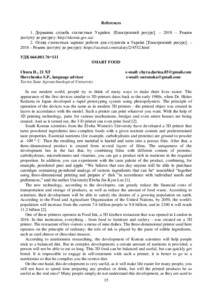Please use this identifier to cite or link to this item:
http://elar.tsatu.edu.ua/handle/123456789/6893Full metadata record
| DC Field | Value | Language |
|---|---|---|
| dc.contributor.author | Chura, D. | - |
| dc.date.accessioned | 2019-05-14T11:18:40Z | - |
| dc.date.available | 2019-05-14T11:18:40Z | - |
| dc.date.issued | 2018 | - |
| dc.identifier.uri | http://elar.tsatu.edu.ua/handle/123456789/6893 | - |
| dc.description.abstract | In our modern world, people try to think of many ways to make their lives easier. The appearance of the first devices similar to 3D printers dates back to the early 1980s, when Dr. Hideo Kodama in Japan developed a rapid prototyping system using photopolymers. The principle of operation of the devices was the same as in modern 3D printers - the printed object was created in layers in accordance with the model. Such a printer can print whatever you want. With the help of 3D printing technology, parts for various mechanisms, bridges and even entire houses are being created. And as it turned out, the 3-D printer can even print food | uk |
| dc.language.iso | en | uk |
| dc.publisher | ТДАТУ | uk |
| dc.relation.ispartofseries | Матеріли Всеукраїнської науково-технічної конференції магістрантів і студентів ТДАТУ (присвячується 80-річчю Запорізької області за підсумками наукових досліджень 2018 року). Кафедра іноземних мов: збірник тез доповідей (Мелітополь, 19-23 листопада 2018 р.);С. 15-16 | - |
| dc.subject | smart food | uk |
| dc.subject | modern 3D printers | uk |
| dc.subject | technology | uk |
| dc.subject | growing vegetables | uk |
| dc.title | Smart food | uk |
| dc.type | Working Paper | uk |
| Appears in Collections: | Публікації здобувачів (бакалаврів. магістрів, аспірантів) | |
Files in This Item:
| File | Description | Size | Format | |
|---|---|---|---|---|
| Ин.яз 98 -15-16.pdf | 196.35 kB | Adobe PDF |  View/Open |
Show simple item record
CORE Recommender
???jsp.display-item.check???
Items in DSpace are protected by copyright, with all rights reserved, unless otherwise indicated.
